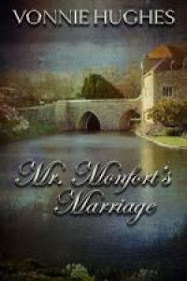THE REGENCY ERA
from Vonnie Hughes
The internet is over-burdened with writersmarketing their wares. And I’m adding to the general plethora out there. Buthear me out.
I’ve been writing Regencies for twenty-fiveyears now. Recently, after many ups and downs in the publishing industry,Regencies have come back in to favor. Yes,fashions come and go in publishing just like everywhere else. And there’snothing new under the sun. My main publisher now is The Wild Rose Press sincemy earlier publishers have closed their doors. I have also joined the endlessqueue of self-published authors. So many of us out here jostling for positionlike mid-field marathoners. The chances are you’ll never hear my plea. But I’mchucking this out there in the anorexic hope that you just might read this.Perhaps you have nothing better to do.
I hope you’re one of the many readers wholike historicals, and in particular, the Regency era. It was such a shortperiod in Britain’s history, but has given rise to many things such as thedevelopment of canals (as trade with its trading partners hotted up with theimprisonment of Napoleon, freeing up trade routes and resulting in largenumbers of goods that needed to be transported all over England), the RoyalAstronomical Society was founded, the early prototype of the bicycle, thedevelopment of the railway system, the Act of Union with Ireland in 1801 etc.All this is from the British point of view. Elsewhere, in the USA, Whitney cameup with the principle of manufacturing interchangeable parts as pertaining tofirearms. The statue of the Venus de Milo was discovered in Greece (1820) andso it goes on.
So in spite of many Regencies persuadingyou that it was all about Almacks and dukes, the Regency era was actually atime on the cusp of great changes, not just in Britain but all over the world.Minds were opening up, no longer relying on the dogma of ages past.
In 1814 The Timesadopted steam printing. By this method it could now print 1,100 sheets everyhour, not 200 as before—a fivefold increase in production capability anddemand. This development brought about the rise of the wildlypopular fashionable novels.
The Regency is also noted for itsachievements in the fine arts and architecture (Nash springs to mind, andremember that striped wallpaper known as ‘Regency’?) This era encompassed atime of great social, political, and economic change that shaped and alteredthe societal structure of Britain as a whole. Remember that in London alone,the population increased from just under a million in 1801 to one and a quartermillion by 1820.
One of the reasons that the artsflourished during this era was because of the patronage of ‘Prinny’, the fatand at times ridiculous Prince of Wales. We might laugh at him, but it’s thanksto him that the development of British architecture flourished, even if hisschemes often left the common people paying for his over-the-top designs.
The Regency era opened up themarket for many authors including Sir Walter Scott, Maria Edgeworth, MaryShelley (who incorporated the general mistrust of science during the earlierpart of the Regency era), John Keats and William Blake. Then there were theplaywrights and artists…the list goes on and on to confirm how minds began opento new possibilities during that time.
Oh yes, there was a lot more to theRegency period than those autocratic dukes and the patronesses at Almacks!
One of my releases is called Mr. Monfort’sMarriage wherein a chivalrous businessman who is not overly fond of thearistocracy finds himself married to an earl’s daughter. She teaches him about noblesse oblige, courage and joie de vivre, and he teaches her…allsorts of things!

A marriage of convenience is not always convenient.
The woman needs saving, so he'll save her. A marriage of convenience should suit them both. But don't expect him to trust her or love her in spite of those knee-trembling smiles and bright intelligence. Women of the ton are not to be trusted. But Verity certainly is enticing...
MatthewMonfort has two excellent reasons for loathing members of the ton, but thanks to his father’smachinations, he finds himself inveigled into offering for Lady Verity Tristan.But she needn’t think she’s going to win him over.
Amazon Buy Link MR. MONFORT’S MARRIAGE
 Vonnie Hughes is a multi-published author in both Regency books and contemporary suspense. She loves the intricacies of the social rules of the Regency period and the far-ranging consequences of the Napoleonic Code. And with suspense she has free rein to explore forensic matters and the strong convolutions of the human mind. Like many writers, some days she hates the whole process, but somehow, she just cannot let it go.
Vonnie Hughes is a multi-published author in both Regency books and contemporary suspense. She loves the intricacies of the social rules of the Regency period and the far-ranging consequences of the Napoleonic Code. And with suspense she has free rein to explore forensic matters and the strong convolutions of the human mind. Like many writers, some days she hates the whole process, but somehow, she just cannot let it go.Vonnie was born in New Zealand, but she and her husband now live happily in Australia. If you visit Hamilton Gardens in New Zealand, be sure to stroll through the Japanese Garden. These is a bronze plaque engraved with a haiku describing the peacefulness of that environment. The poem was written by Vonnie.
All of Vonnie’s books are available on The Wild Rose Press and Amazon .
Learn more about Vonnie Hughes on her website and blog . Stay connected on Facebook and Goodreads .



